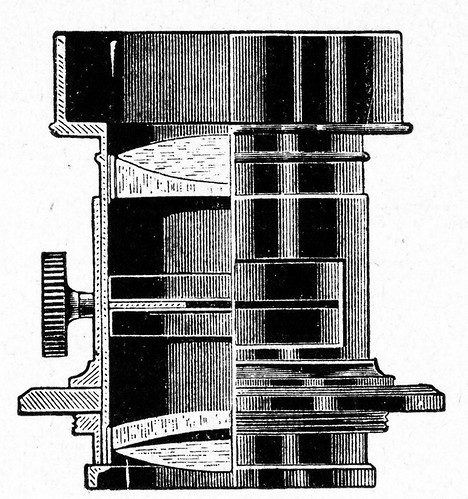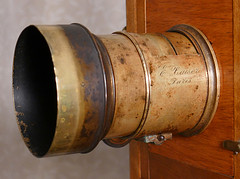Difference between revisions of "Petzval lens"
(Updated cineressources link in footnote, and 'Notes', not 'References') |
Hanskerensky (talk | contribs) (→Links: <!--Commented out link, page no longer present/available, please remove if not returned by 05/2016 -->) |
||
| Line 64: | Line 64: | ||
*[http://en.wikipedia.org/wiki/Petzval_lens Petzval lens] article at [http://en.wikipedia.org/ Wikipedia] | *[http://en.wikipedia.org/wiki/Petzval_lens Petzval lens] article at [http://en.wikipedia.org/ Wikipedia] | ||
*[http://www.antiquecameras.net/softfocuslenses.html Antique & Classic Soft Focus Lens Article] | *[http://www.antiquecameras.net/softfocuslenses.html Antique & Classic Soft Focus Lens Article] | ||
| − | * The Petzval lens is discussed in [http://pluslucis.univie.ac.at/FBA/FBA99/Sporn/8.pdf ''Der Österreichische Beitrag zur Fotografie''] (the Austrian contribution to photography), chapter 8 of [http://pluslucis.univie.ac.at/FBA/FBA99/Sporn/index.html Historische Verfahren in der Fotografie] (Historical methods in photography) by Christian Sporn, a candidate for an award by the Österreichische Physikalische Gesellschaft in 1999; hosted by the [http://pluslucis.univie.ac.at/vfpc/index_vfpc.html Verein zur Förderung des physikalischen und chemischen Unterrichts] (Association for the Promotion of Physical and Chemical Education) at the University of Vienna. | + | <!--Commented out link, page no longer present/available, please remove if not returned by 05/2016 * The Petzval lens is discussed in [http://pluslucis.univie.ac.at/FBA/FBA99/Sporn/8.pdf ''Der Österreichische Beitrag zur Fotografie''] (the Austrian contribution to photography), chapter 8 of [http://pluslucis.univie.ac.at/FBA/FBA99/Sporn/index.html Historische Verfahren in der Fotografie] (Historical methods in photography) by Christian Sporn, a candidate for an award by the Österreichische Physikalische Gesellschaft in 1999; hosted by the [http://pluslucis.univie.ac.at/vfpc/index_vfpc.html Verein zur Förderung des physikalischen und chemischen Unterrichts] (Association for the Promotion of Physical and Chemical Education) at the University of Vienna. --> |
*[http://www.flickr.com/groups/868027@N25/ Petzval lens photographs] Flickr group | *[http://www.flickr.com/groups/868027@N25/ Petzval lens photographs] Flickr group | ||
*[http://dioptrique.info/base/i/i_petzval.HTM Objectif de Petzval] French article on design, 3rd order curves and images | *[http://dioptrique.info/base/i/i_petzval.HTM Objectif de Petzval] French article on design, 3rd order curves and images | ||
Revision as of 06:28, 30 November 2015

|
| Half-section diagram of Petzval lens, from Voigtländer literature. scanned by Uwe Kulick (Image rights) |
The Petzval lens (or Petzval portrait lens) is the oldest notable lens design for photography. It was calculated and designed by the native Slovakian mathematician and physicist Jozef Maximilián Petzval, and first used for Voigtländer's early metal camera "Daguerreotyp-Apparat zum Portraitiren" in 1841. It was the first camera lens made on the basis of scientific calculation, and was the fastest lens of its time, with an aperture of around f/3.5 - compared to the f/16 or more of typical contemporary camera lenses. This could reduce the average Daguerreotype exposure time from around 10 minutes to 30 seconds.
The design has two separate doublet elements; the front one cemented and the rear one (in the original design) with an air gap (as shown in the illustration). An aperture stop is placed between the two doublets.
The lens gave sharp definition in the centre, but covered only a small field for its focal length, and tended to vignette.[1] These features were quite acceptable for portraiture, and lenses based on the Petzval design remained in use for studio portraiture for many years.[2]
Photos

|
| Voigtländer & Sohn Petzval lens image by Pete Strasser (Image rights) |

|
| Voigtländer & Sohn Petzval lens image by Pete Strasser (Image rights) |

|
| Voigtländer & Sohn Petzval lens image by Pete Strasser (Image rights) |

|
| Petzval lens by E. Baiser of Paris. image by tokyogaz (Image rights) |
Notes
- ↑ Greenleaf, Allen R. (1950) Photographic Optics. Macmillan, New York. pp67-8.
- ↑ The Ross Catalogue of 1912 (p 15), seventy years after Petzval's invention, states "For Studio purposes the lenses employed have, until recently, been almost exclusively of the Petzval type. These excellent lenses give central sharpness for Busts and Single Figures, but for Groups and Pictures requiring more extensive covering our "Homocentrics" are now largely used, possessing as they do a defination (sic) more perfect both at centre and margin than any other Anastigmats."
Links
- A History of the Petzval Lens at Antique and classic cameras
- Petzval lens brief at Sinclair Optics
- Petzval lens article at Wikipedia
- Antique & Classic Soft Focus Lens Article
- Petzval lens photographs Flickr group
- Objectif de Petzval French article on design, 3rd order curves and images
- 35 cm Voigtländer Petzval lens, about 1863, sold at the 23rd Westlicht Photographica Auction, on 25 May 2013.